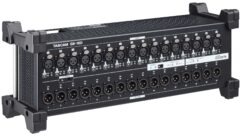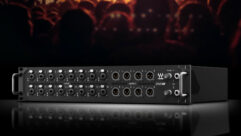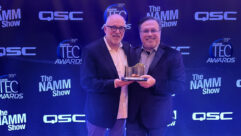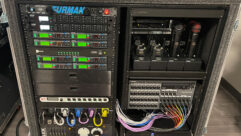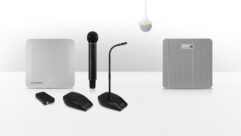
Houses of Worship — June 16, 2005
Jun 16, 2005 3:47 PM
Houses of Worship Top Story
Summer Poses Challenge for Church AV
Summer is when the days get longer, the sun gets hotter, and—all too often—the church volunteers get going.
They’re off to the beach, to the mountains, to summer school, or perhaps just to a hammock in the backyard. Even if their bodies aren’t wandering, frequently their minds are, with consequences for any church that relies on volunteers to run its worship media systems.
“This is a real problem for most houses of worship,” says Hector La Torre, president of Fits & Starts Productions, which produces audio training programs geared to volunteers and other church personnel. “Most churches start out understaffed in the technology areas, so summer months, as well as any emergency, definitely leave them short of help.”
It doesn’t take an emergency, though. A summer camp can present a challenge. At the Independent Bible Church in Port Angeles, Wash., Sheldon Koehler, director of technical ministries, says, “Our team is large enough that summer does not hamper us that much. The only week that is a stretch is during the high school camp. [If] the portable sound equipment goes out, I lose a sound guy, a video operator, and a projectionist all at once. It makes scheduling a small challenge.”
Koehler’s experience appears to be fairly typical. A recent discussion thread at Churchmedia.net brought out a variety of comments on the summer vacation season, and indicated that most churches expect their volunteers to arrange their own replacements when they’re going away.
“We have several situations that tend to put us in a bind,” one poster reported. “When the senior high youth have an outing, I lose my computer operator, at least one song team member, and frequently a sound man, too.”
Some churches can keep things going 100 percent during vacation season, but many can’t. La Torre says, “Frankly, many churches don’t overcome this problem, and wind up having the pastor, minister, or someone ‘set-and-forget’ the system, hoping that all will go well. Some churches cope by having volunteers work out vacation schedules with church administrator—but again, with volunteer shortages, even that does not work out well.”
“Churches do scale back their media operations in the summer, and try not to schedule major productions during vacation months,” La Torre says. However, he adds, this is just one symptom of a broader difficulty: the overall lack of training for volunteers. Fits & Starts workshops travel around the country and find enthusiastic acceptance from churches wherever they go, La Torre says.
But even this enthusiasm merely reflects the fact that many churches are short of volunteer help, and even in those with plenty of bodies available, the technical savvy often falls short.
The ultimate answer, La Torre says, is “getting enough volunteers up to speed on technology.”
Installation News
EAW’s DSA Series Loudspeakers Solve Unique Audio Challenges for Dallas-area Church
Changing the look and feel of a church will usually dramatically impact the sound dynamics as well—and the results of such a change can often be a mixed bag. This is exactly what Northway Christian Church of Dallas discovered after renovating its sanctuary as part of a larger expansion project.
“We were giving the sanctuary a facelift in conjunction with a project to build 6,000 square feet of additional space for a choir rehearsal room and a multipurpose area,” says Mark Bender, minister of youth and administration for Northway Christian Church. “We knew that taking down the acoustical panels would impact the sound, but we didn’t anticipate how much sound the carpeted seating area also absorbed. After we pulled up the carpet, the sound was hitting the bare floor and bouncing off the walls.”
The changes added 1.25 seconds of reverberance, for a total of more than three seconds of echoes. “The resonance of the pipe organ and the choir were really great, but the spoken word was a garbled mess,” Bender says. “It was so bad that people were cupping their hands over their ears just to try to keep the echoes out.”
While everyone enjoyed the music in the renovated space, church leaders knew they had to improve speech intelligibility. They consulted with Chris Jordan, president and founder of Electro Acoustics & Video in Forth Worth, Texas. “At first, I was pretty certain the church would have to reinstall the acoustical panels to achieve a more desirable reverb time of two seconds,” Jordan says. “However, I’d heard about EAW‘s DSA Series line arrays, which can steer the output directly at the congregation, and away from the troublesome reflective surfaces.”
EAW’s DSA Series loudspeakers use digital signal processing technology and onboard amplification to allow steering of the loudspeakers’ output pattern. Using the DSA Pilot software program, users can vary the vertical coverage pattern from 15 degrees to 120 degrees, as well as aim the coverage up or down by as much as 30 degrees. In this way, sound can be carefully directed in the vertical plane toward listeners without physically moving or adjusting the loudspeaker enclosure itself.
“The DSA Series appeared to be an elegant solution to the problems at Northway,” Jordan notes. “This was a tough room and I was still concerned that we’d possibly need to re-install the panels.”
Setting his concerns aside, Jordan took a leap of faith and arranged to borrow a DSA system from his local EAW rep for a demo. According to Bender, “Chris’ team first played the old speakers and then switched over to the DSA system. There was a dramatic improvement. We were ready to sign a purchase order immediately.”
For about the same cost as the complete set of new acoustical panels that Jordan expected to recommend, the church instead purchased two DSA250 loudspeakers and two DSA230 subwoofers—all were connected to the church’s existing FOH console.
Solving the problem affordably was not all that Jordan found impressive about the DSA speakers. “The DSAs are incredibly compact and unobtrusive for all the sound they put out, but we made them even less noticeable when we painted them to match the walls,” Jordan explains. “So despite [their] being surface-mounted on the front wall of the church, you have to really look to see where the sound is coming from. For a church whose goal was to give its sanctuary a facelift, we did pretty well by eliminating the bulky black speaker cabinets and reducing the need for additional acoustical panels.”
According to Bender, the church has been just as pleased with its find. “With the new sound system, you can actually understand the spoken word better than ever,” he says. “Best of all, the system preserves the aesthetics of our church—which was the whole point of renovation in the first place.”

Innovason Digital Console and Sennheiser Wireless—The Finishing Touches for Cartersville Baptist Church
When you move into a new home, sometimes the old stuff just doesn’t work anymore. Cartersville Baptist Church, Cartersville, Ga., found that to be the case when it moved into a new church building last April. Despite a brand-new, state-of-the-art sound system in the new building, the church brought along the mixing console and wireless microphones used in its previous facility. It didn’t take long for the church to realize those components should have been left behind.
After several months of muddling through with the old FOH system, it fell to the church’s newly hired technical ministries director to hunt down a new solution. Coming on board in August, Tony Serna’s first thought was to go with the brands he had worked with in the past.
“My first job was to get the audio system completed, and my initial reaction was to go with what I knew,” says Serna, who has a background in music theater production.
The more he talked to colleagues who had participated in product shootouts, though, two names kept popping up—ones he hadn’t originally considered. For the console, it was Innovason, and for the wireless microphones, it was Sennheiser.
As he studied the options, it became clear that both brands, each distributed by Sennheiser Electronics Corporation, offered the elusive mix of quality, affordability, and user-friendliness the church needed to meet its contemporary worship needs.
Working with Florida-based audio dealer David McKenna of Mega Pro Audio, Serna settled on the Innovason Compact Sy40 digital mixing console. Designed for the budgets and technical needs of users with medium-size live music applications, the Sy40 ended up being the perfect fit.
“The bigger Innovason Sy80 was a lot more console than we needed, and our input-output needs better fit the parameters of the Sy40, which is equipped with 40 physical inputs and 16 outputs,” Serna says. “We’ve ended up using almost all of its capabilities—32 inputs and 16 outputs—because we incorporate both drama productions and extensive live music with instruments and vocalists into our services. We have a fairly full stage Sunday morning, and we need to be able to integrate everything from a rhythm section to a vocalist to a full band.”
With such a varied slate of stage activities taking place on Sunday, as well as other times during the week, the church needed a mixing console that would make life easier for the production staff. In that respect, the Sy40 was ideal, he says.
“One of the things we like about it is its ability to do full recall,” he says. “With a veritable performing arts stage that’s changing on a regular basis we needed a flexible console. The recall capability is nice because we’ll rehearse different elements of the Sunday service through the week, and do other things as well in the auditorium. So we have to be able to make a lot of changes in mix settings very quickly, but bring things all back together for Sunday.”
Other features Serna likes about the Sy40 include its “clean” mic preamps, compressors and gates that “work like they should,” and large display that allows operators to clearly see what they’re doing.
For all its power and sophistication, the Sy40’s ease of setup is impressive, Serna says. That was important given the narrow window he had to get the console up and running at one of the busiest times of the year—the winter holidays.
“We basically installed it between rehearsals for the Christmas production schedule,” he says. “It looks like a more intimidating desk than it really is. Integrating it turned out to be easier than we anticipated, even with our staff of volunteers.”
A complement of Sennheiser wireless microphones turned out to be another pleasant surprise for the church. Having worked primarily with Sennheiser’s major competitor for past jobs, Serna was initially reluctant to switch. But switch he did, signing up for four handheld and eight bodypack units in the Sennheiser Evolution G2 100 Series.
Notes Serna, “When I first saw the bodypack units, what struck me was the size. They’re smaller than the ones I’ve used in the past, but they looked very rugged. In fact, the G2 system looked like a pretty bomb-proof system, and that’s so important when they’re subjected to high temperatures and humidity during rigorous stage performances.”
The eight bodypack units, which are paired with a complement of both headset and lapel microphones, have withstood the abuse and produced a sound quality that rivals that of any competitor, Serna says. The handheld units, which consist of a Sennheiser 152 capsule on a G2 transmitter body, have also proven their mettle.
“We had a choice of three capsules and went with the higher-end one,” he says. “That was one of the attractive things about the Sennheiser package—we could pair a high-end capsule with a mid-end transmitter that met our budget needs.”
Serna is so impressed with both the Sennheiser mics and the Sy40 console that he plans to add more to the church’s audio equipment inventory. Another Innovason console is slated for use in a broadcast booth, while more wireless mics are being eyed for a children’s theater and a youth theater. “They’ll get even more abuse in those environments, but we feel confident Sennheiser wireless will hold up.”
Product News

Soundcraft Dual-mode Console Family Extended with MH2
Soundcraft has taken advantage of this year’s InfoComm Show to unveil its new MH2, the latest model in the manufacturer’s popular MH Series of dual-mode performance consoles.
Aimed at touring companies and installations of all sizes, the eagerly anticipated MH2 fits in at a very affordable price point and is one of the few consoles at this level to offer VCA grouping. The MH2 is bound to find favor with churches, theaters, nightclubs, and other similar installs due to its high channel count within a compact frame, and generous matrix, VCA groups, and LCR panning. Touring companies will further readily appreciate the MH2’s ability to minimize inventory expenditures thanks to its multipurpose design.
Alongside its bigger brothers—the MH3 and MH4—the MH2 is similarly capable of dual-mode (FOH/monitor) operation and features eight subgroups, 10 auxiliary busses, eight VCA groups, and six mute groups, as well as an integral 11×4 matrix.
Available in 24, 32, 40, and 48 mono channel frame sizes, all with four comprehensive, full-function stereo inputs as standard, the new console benefits from a monocoque chassis with individual channel PCBs, providing a rugged yet cost-effective mixer solution for applications in touring sound, theater, corporate events, and installations that demand both a large number of channels and small footprint.
As with the MH3 and MH4, the MH2 can be switched from FOH mode to monitor mode, whereby 10 60mm faders can control the auxiliary outputs instead of the groups for monitor use. In FOH mode, these faders normally control the eight group outputs plus two of the auxiliary sends.
Four stereo returns are provided, each with a four-band EQ section, feeding the main mix busses.
“Our customers asked for a console with the sound quality and ergonomics of our successful MH3 and MH4, but in a smaller footprint,” comments Andy Brown, Soundcraft’s tour sound product manager. “The new MH2 delivers exactly that and will undoubtedly find favor on budget- or space-restricted jobs, both in installations and on the road.”
There seems little doubt that the MH2 will prove popular in touring sound seeing that the MH3 and MH4 have gained fans at high-profile companies like Britannia Row and Adlib Audio. MH Series desks have also shown up in a wide array of notable installs, including The Cavern Club in Liverpool, England, Utah Symphony‘s Abravanel Hall, and Toronto’s Queensway Cathedral. Most recently, an MH4 was used to mix sound for the hit television series American Idol.
Suggested U.S. retail pricing on the new MH2 is as follows:
24 mono and four stereo channels: $11,595
32 mono and four stereo channels: $13,495
40 mono and four stereo channels: $14,995
48 mono and four stereo channels: $16,950

Panasonic Announces 3500-lumen PT-D3500U One-chip DLP XGA Projector for Multitude of Venues
At InfoComm, Panasonic introduced a key addition to its popular line of ultra-bright DLP projectors—the one-chip PT-D3500U—which provides the visual impact, outstanding performance, and return on investment users have been looking for in a cost-effective unit.
The PT-D3500U’s high-precision DLP system in concert with the projector’s high-power UHM lamp displays visually stunning, ultra-crisp 1024×768 XGA resolution images at a high-contrast ratio of 1600:1. With a brightness of more than 3500 lumens and a compact design, this XGA DLP projector is suitable for a broad range of venues, ranging from classrooms and meeting rooms, to retail stores and showrooms, to exhibits and public spaces. The PT-D3500U offers user-friendly features including lens shift, center lens design, a range of interchangeable lenses, and all the benefits of an economical DLP engine.
Compact at 17.4lbs., the PT-D3500U is equipped with a high-contrast, one-chip DLP engine with a 0.7in. XGA Digital Micromirror Device. The performance, reliability, and precision of its patented optical engine are further enhanced by the use of a coreless air bearing motor for the color wheel, resulting in a projection system a full class above other single-chip systems. Its lens-centered design provides flexibility in system design because it eliminates the need for any special considerations when planning the unit’s installation. A wide adjustment of the horizontal/vertical lens shift assures distortion-free images and adds convenience and versatility.
Five optional lenses with different throw distances are available in addition to the supplied lens, enabling the projector to perform superbly in an array of projection environments—and to exchange lenses with Panasonic’s PT-D5500 one-chip DLP projector. A mechanical lens shutter eliminates light leakage when engaged, a feature that distinguishes the projector from others in its class.
Setup of the PT-D3500U is easy with one-touch auto setup with manual horizontal and motorized vertical lens shift and Digital Keystone Correction. For exceptional connection flexibility, the projector offers a full array of input terminals, including a DVI-D connector (HDCP compliant), audio input/output terminals, two computer (RGB), and three video (component, composite, and S-Video). In addition, the PT-D3500U has a wired LAN connector, RS-232C, and external remote terminals.
When it is connected to a wired LAN, a user can operate a PT-3500U remotely and check its status using a web browser on a networked PC, and the projector can send e-mail messages to notify a user when the unit’s operating condition changes or a lamp needs replacing. The wired LAN connection drives down support costs and minimizes downtime, and is highly beneficial in a fixed installation.
Designed for quiet operation, the PT-D3500U is HDTV-ready, and can automatically synchronize to display 1080i, 720p, 480p, and 480/576i video in the 16:9 wide aspect ratio. Its Direct Power Off function keeps the projector’s fan running to cool down the unit even when the power is turned off. The PT-D3500U offers several security features to prevent unauthorized use, including password protection, operation key lock, Kensington lock, and a security chain opening.
The PT-D3500U uses a bayonet-type lens system, so lenses attach and detach with one-touch ease. In addition, its lamps can be easily replaced from the back panel by removing one screw. The unit measures 6 5/8″x13 1/16″x16 23/32″ and weighs a modest 17.4lbs.
Other key benefits include: projection on screens from 50in. to 600in.; six-color matching function (red, green, blue, cyan, magenta, yellow); ID assignment for up to 65 units; coordinated group control for up to 26 groups (A-Z); 3X digital zoom; built-in test pattern; and selectable nine-language on-screen menu.
The PT-D3500U will be available in August at a suggested list price of $6,999.
Optional lenses available for the PT-D3500U include the ET-DLE100 1.3—1.8:1 zoom lens, ET-DLE200 2.5—4.0:1 zoom lens, ET-DLE300 3.7—5.7:1 zoom lens, the ET-DLE400 5.7—8.0:1 zoom lens, and ET-DLE050—0.8:1 fixed-focus lens.
Other options include the ET-PKD35 ceiling-mount bracket for permanent installation and ET-PKD35S for low ceilings, and the ET-RMRC2 full-function wireless mouse remote control.
For more information on the PT-D3500U series and Panasonic’s complete line of projectors, visit www.panasonic.com/projectors.

Christie Introduces The New ChristieNet Wave-DVD
Christie is pleased to introduce the ChristieNet Wave-DVD, a high-performance wireless audio-video system for VGA, component, and S-Video sources designed to dramatically increase connectivity options, while at the same reducing the cost of installations.
The wireless answer for dynamic presentations and quality video including DVD content, the ChristieNet Wave-DVD transmits and receives high-quality 480i resolution for high-impact, full-motion video. With a unique and highly effective compression solution, you can operate at ranges of up to 500ft. (152.4m), delivering wireless video at 30fps.
With flexible and easy-to-use wireless solutions like the ChristieNet Wave-DVD, applications in videoconferencing, digital signage, courtrooms, and houses of worship just got a big wireless boost from Christie.
The ChristieNet Wave-DVD system is secure and standards-based, compatible with virtually any PC, display, or operating system, and requires no drivers, software, or OS upgrades. It features plug-and-play capability and easy setup and adjustment, and it supports multiple receivers for broadcast mode. The system can easily be optimized to match the source with the display to ensure the perfect audio video settings. Additionally, the wireless transceivers pass through RS-232, allowing for remote monitoring of display devices via the ChristieNet CCM and ChristieNet Network Management Software.
For more information on the ChristieNet Wave-DVD, and other Christie AV networking solutions, please visit www.christiedigital.com and login to the Christie Partner section.


